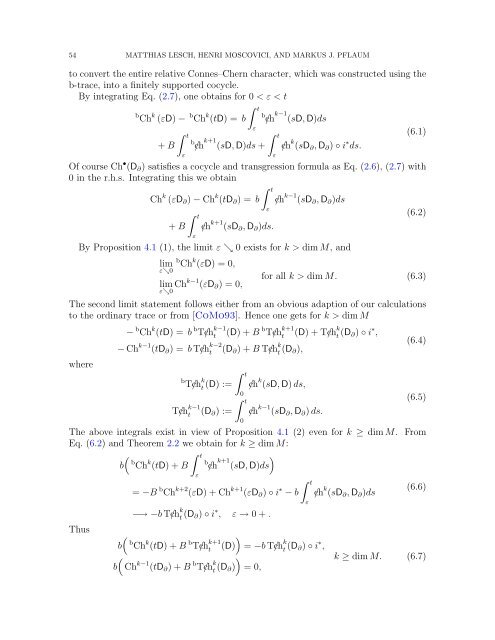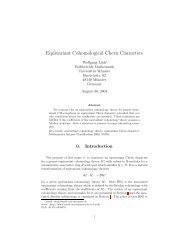Connes-Chern Character for Manifolds with Boundary and ETA ...
Connes-Chern Character for Manifolds with Boundary and ETA ...
Connes-Chern Character for Manifolds with Boundary and ETA ...
Create successful ePaper yourself
Turn your PDF publications into a flip-book with our unique Google optimized e-Paper software.
54 MATTHIAS LESCH, HENRI MOSCOVICI, AND MARKUS J. PFLAUM<br />
to convert the entire relative <strong>Connes</strong>–<strong>Chern</strong> character, which was constructed using the<br />
b-trace, into a finitely supported cocycle.<br />
By integrating Eq. (2.7), one obtains <strong>for</strong> 0 < ε < t<br />
b Ch k (εD) − b Ch k (tD) = b<br />
+ B<br />
∫ t<br />
ε<br />
∫ t<br />
b /ch k+1 (sD, D)ds +<br />
ε<br />
b /ch k−1 (sD, D)ds<br />
∫ t<br />
ε<br />
/ch k (sD ∂ , D ∂ ) ◦ i ∗ ds.<br />
(6.1)<br />
Of course Ch • (D ∂ ) satisfies a cocycle <strong>and</strong> transgression <strong>for</strong>mula as Eq. (2.6), (2.7) <strong>with</strong><br />
0 in the r.h.s. Integrating this we obtain<br />
Ch k (εD ∂ ) − Ch k (tD ∂ ) = b<br />
+ B<br />
∫ t<br />
ε<br />
∫ t<br />
/ch k+1 (sD ∂ , D ∂ )ds.<br />
ε<br />
/ch k−1 (sD ∂ , D ∂ )ds<br />
By Proposition 4.1 (1), the limit ε ↘ 0 exists <strong>for</strong> k > dim M, <strong>and</strong><br />
lim<br />
b Ch k (εD) = 0,<br />
ε↘0<br />
lim<br />
ε↘0 Chk−1 (εD ∂ ) = 0,<br />
(6.2)<br />
<strong>for</strong> all k > dim M. (6.3)<br />
The second limit statement follows either from an obvious adaption of our calculations<br />
to the ordinary trace or from [CoMo93]. Hence one gets <strong>for</strong> k > dim M<br />
where<br />
− b Ch k (tD) = b b T/ch k−1<br />
t<br />
(D) + B b T/ch k+1<br />
t<br />
(D) + T/ch k t (D ∂) ◦ i ∗ ,<br />
− Ch k−1 (tD ∂ ) = b T/ch k−2<br />
t<br />
(D ∂ ) + B T/ch k t (D ∂),<br />
∫ t<br />
b T/ch k t (D) := /ch k (sD, D) ds,<br />
T/ch k−1<br />
t<br />
(D ∂ ) :=<br />
0<br />
∫ t<br />
0<br />
/ch k−1 (sD ∂ , D ∂ ) ds.<br />
(6.4)<br />
(6.5)<br />
The above integrals exist in view of Proposition 4.1 (2) even <strong>for</strong> k ≥ dim M. From<br />
Eq. (6.2) <strong>and</strong> Theorem 2.2 we obtain <strong>for</strong> k ≥ dim M:<br />
(<br />
∫ t<br />
)<br />
b<br />
b Ch k (tD) + B<br />
b /ch k+1 (sD, D)ds<br />
Thus<br />
b<br />
(<br />
b<br />
(<br />
ε<br />
= −B b Ch k+2 (εD) + Ch k+1 (εD ∂ ) ◦ i ∗ − b<br />
−→ −b T/ch k t (D ∂) ◦ i ∗ , ε → 0 + .<br />
b Ch k (tD) + B b T/ch k+1<br />
t<br />
)<br />
(D)<br />
)<br />
Ch k−1 (tD ∂ ) + B b T/ch k t (D ∂)<br />
∫ t<br />
= −b T/ch k t (D ∂) ◦ i ∗ ,<br />
= 0,<br />
ε<br />
/ch k (sD ∂ , D ∂ )ds<br />
(6.6)<br />
k ≥ dim M. (6.7)

















